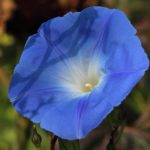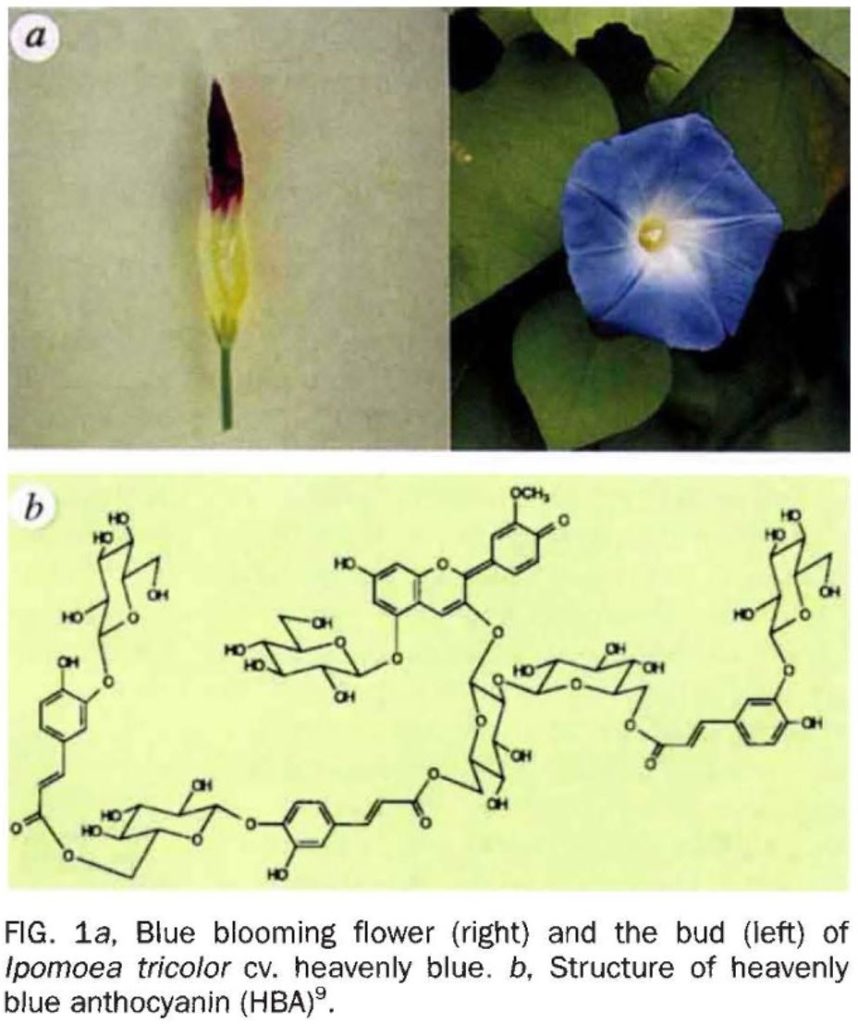By Alastair Culham

I’m using my botanical knowledge to interpret ‘blue convolvulus’ as morning glory (Ipomoea tricolour Cav.). The second plant mentioned in this Christmas book is described as ‘clinging’, and the alternative blue convolvulus is Convolvulus sabatius Viv. which sprawls but does not cling. Such indirect pieces of information can be crucial in identifying a plant but can be very difficult to teach in ID classes.
‘Heavenly Blue’ and ‘Flying Saucers’
The morning glory is a widely planted garden ornamental with a range of cultivars. I. tricolor is grown for the stunningly intense blue flowers produced in profusion through the growing season (mid to late summer in the UK but all year round in warm regions). Remarkably the cause of the blue colour was not worked out until 1995 when a paper by Yoshida in Nature explained the chemistry (Figure 1).

Ipomoea tricolor cv. heavenly blue. b, Structure of heavenly
blue anthocyanin (HBA)
Pumping ion
The paper demonstrated that the blue was due to a rise in the cellular pH causing the purple bud pigmet to change to blue. This is a similar situation to using red cabbage extract as a pH indicator (Compound Interest, 2017) which I’ve done many times on field courses. Basically the anthocyanin, in this case a form of peonidin called “3-0-(2-0-(6-0-(trans-3-0-(β-D-glucopyranosyl)caffeyl)-β-D-glucopyranosyl)-6-0 -(trans-4-0-(6-0-(trans-3-0-(β-D-glucopyranosyl)caffeyl)-β-D-gluco-pyranosyl)caffeyl)-β-D-glucopyranosyl)-5-0-(β-D-glucopyranosyl)peonidin” reacts to the rising cell pH by gradually changing from purple at pH 6.37 to a wonderful light blue at pH 7.68. In 2009, Yoshida et al. finally demonstrated that the pH change in the vacuole containing the anthocyanin was caused by an exchange of H+ for K+ ions that were actively pumped across the cell membrane via the tonoplast-localized Na+/H+ exchanger (NHX).
It sometimes flabbergasts me what complexity in biochemistry has developed in plants. In this case a hugely complex pigment combines with an energy intensive ion pump simply to change the colour from a flower bud to an open flower. When you next grow this plant, make sure you label it Ipomoea ‘Heavenly 3-0-(2-0-(6-0-(trans-3-0-(β-D-glucopyranosyl)caffeyl)-β-D-glucopyranosyl)-6-0 -(trans-4-0-(6-0-(trans-3-0-(β-D-glucopyranosyl)caffeyl)-β-D-gluco-pyranosyl)caffeyl)-β-D-glucopyranosyl)-5-0-(β-D-glucopyranosyl)peonidin pH 7.7″.
As it’s the wrong time of year in the UK to plant Ipomoea seeds, but the right time of year for red cabbage, I suggest you now make yourself a red cabbage rainbow. I guarantee it’s fun.
“— blue convolvulus clinging to every little shanty.”
Have you worked out the book yet?
References
Compound Interest, 2017. https://www.compoundchem.com/2017/05/18/red-cabbage/
Kondo, T., Kawai, T., Tamura, H. and Goto, T., 1987. Structure determination of heavenly blue anthocyanin, a complex monomeric anthocyanin from the morning glory ipomea tricolor, by means of the negative NOE method. Tetrahedron Letters, 28(20), pp.2273-2276.
Yoshida, K., 1995. Cause of blue petal colour. Nature, 373, p.291.
Yoshida, K., Miki, N., Momonoi, K., Kawachi, M., Katou, K., Okazaki, Y., Uozumi, N., Maeshima, M. and Kondo, T., 2009. Synchrony between flower opening and petal-color change from red to blue in morning glory, Ipomoea tricolor cv. Heavenly Blue. Proceedings of the Japan Academy, Series B, 85(6), pp.187-197.

